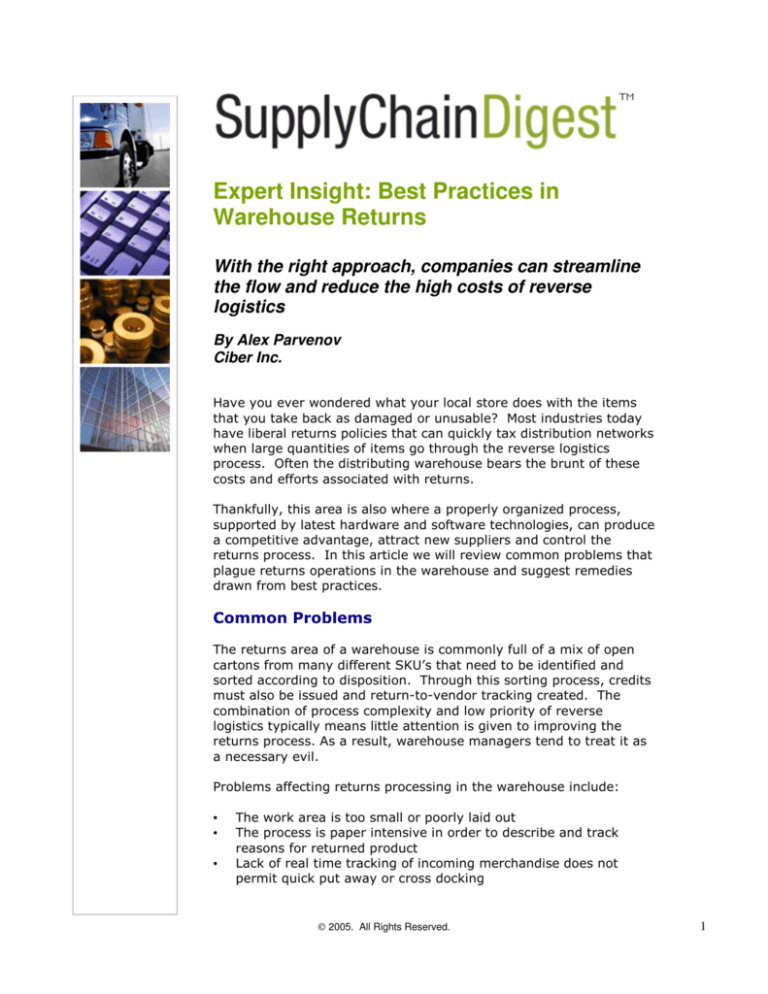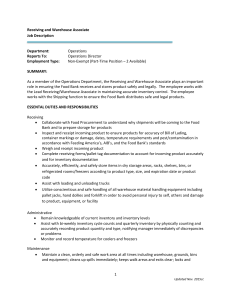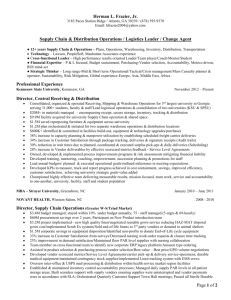
Expert Insight: Best Practices in
Warehouse Returns
With the right approach, companies can streamline
the flow and reduce the high costs of reverse
logistics
By Alex Parvenov
Ciber Inc.
Have you ever wondered what your local store does with the items
that you take back as damaged or unusable? Most industries today
have liberal returns policies that can quickly tax distribution networks
when large quantities of items go through the reverse logistics
process. Often the distributing warehouse bears the brunt of these
costs and efforts associated with returns.
Thankfully, this area is also where a properly organized process,
supported by latest hardware and software technologies, can produce
a competitive advantage, attract new suppliers and control the
returns process. In this article we will review common problems that
plague returns operations in the warehouse and suggest remedies
drawn from best practices.
Common Problems
The returns area of a warehouse is commonly full of a mix of open
cartons from many different SKU’s that need to be identified and
sorted according to disposition. Through this sorting process, credits
must also be issued and return-to-vendor tracking created. The
combination of process complexity and low priority of reverse
logistics typically means little attention is given to improving the
returns process. As a result, warehouse managers tend to treat it as
a necessary evil.
Problems affecting returns processing in the warehouse include:
▪
▪
▪
The work area is too small or poorly laid out
The process is paper intensive in order to describe and track
reasons for returned product
Lack of real time tracking of incoming merchandise does not
permit quick put away or cross docking
2005. All Rights Reserved.
1
▪
▪
Poor process integration into the warehouse does not allow returned merchandise
to be immediately allocated and shipped. Orders are often shipped short, while
saleable inventory is present on the returns dock
Lack of tracking and accountability for un-saleable merchandise that is used to
bill back the vendor
The problems in the customer service department include:
▪
▪
▪
Slow, error prone data entry and credit processing based
on a multitude of papers delivered from the returns dock
No link between data collection and credit processing,
allowing over-credit given to the customer
It is difficult to segregate problems by customer,
salesperson, truck driver or warehouseman to eliminate
misconduct
Best Practices Process
Despite the fact that
returns operations
are inherently
problematic and do
not yield to simple
automation,
companies can gain
competitive
advantage by
applying some of the
industry’s best
practices.
Despite the fact that returns operations are inherently problematic and do not yield
to simple automation, some companies have gained competitive advantage by
applying some of the industry’s best practices. We will analyze a best practice
process from two aspects: business processes and data collection and flow.
Business Processes
Returns are fundamentally complex because of how they impact physical inventory,
electronic inventory and accounting systems. All items must be identified, assigned
to a customer or account, assigned a disposition and then physically sorted for
processing. Since some of the product might be discarded or kept back for vendor
chargeback’s, not all merchandise enters electronic inventory; some merchandise
must be repacked and accounted for manually versus electronically. Finally, credits
are generally issued at a later time and often for only some part of a return,
including discarded or un-saleable goods. This process is difficult to automate with a
generic ERP package and very challenging with a simple paper process. Specialized
returns systems, whether part of a Warehouse Management System (WMS) or
stand-alone, can support effective automation with appropriate setup. The software
must:
▪
Separate the physical process from the accounting process and allow for gaps
between physical and accounting realities. For example, out of a returned pallet
only part of the pallet may be added to inventory and a different part of it may
be credited to the customer.
▪
Separate responsibility over physical inventory from responsibility over customer
credits. A warehouse employee should not be concerned with how and when a
customer will receive credit. Credit processors use an electronic transaction log of
returns dock activity to release customer credits.
▪
Distinguish between return reasons and physical disposition. The former
describes why customer returned it. The latter describes physical state of the
merchandise. Credit clerks must understand return reasons. Warehouseman
must understand the dispositions.
2006 All Rights Reserved.
2
▪
Try to control the returns process through “Returns
Authorizations.” With Return Authorizations, the preapproved returns can be received quickly thereby
simplifying the returns identification and speeding
overall processing. To enable radio frequency (RF)
equipment automation and verification, these expected
returns should be entered into the system prior to
arrival.
▪
Stage saleable merchandise by a putaway zone. Most
of the returned merchandise is generally in saleable
condition and will be returned to the storage area. To
streamline the subsequent put away process, saleable
products should be staged on pallets by destination
zone.
▪
Track un-saleable merchandise with a bar-coded label. Any merchandise that is
not saleable and cannot be discarded is usually stored according to vendor
guidelines. While some vendors simply require an inventory report to issue
credits, others will send a sales representative to inspect the goods or to ship to
the vendor. A complete audit trail consisting of return reason, date of initial
shipment, date of return, customer name, etc. will assure legitimacy of the claim
and improve supplier relationships.
Look for returns
processing modules
that can be tightly
integrated with the
Warehouse
Management System.
This allows for realtime inventory
control, immediate
inventory allocation,
instant picking from
the returns area, and
cross-docking to a
shipping dock.
Data Collection and Flow
The second aspect to analyze a best practice process is from data collections and
flow.
▪
Handheld Scanners: Just as RF equipment has proven indispensable in the
warehouse environment; this technology is especially valuable in the returns
process. RF screens should prompt for RMA#, SKU or UPC code, quantity,
disposition and physical state of the merchandise.
▪
Interface into WMS: Returns processing modules should be tightly integrated
into the existing WMS. The integration allows for real-time inventory control,
immediate inventory allocation, instant picking from the returns area, and crossdocking to a shipping dock.
▪
Interface into Accounting System: Any data collected about returned
merchandise should be made available to the accounting system to serve as a
basis for credit processing. This data flow ensures that credits are issued only
after merchandise is inspected. It also reduces opportunities for crediting errors.
2006 All Rights Reserved.
3
Summary
Prudent and consistent application of RF technology, reengineering of business
processes, and streamlining of physical operations based on industry’s best
practices, warehouse managers can enjoy increased throughput and accuracy while
driving improvements to the organization’s bottom line.
Alex Parvenov is a Senior Consultant in the Supply Chain Practice of CIBER, Inc. He
has built and deployed large scale Warehouse Management Systems in various
industries, both domestically and internationally. Mr. Parvenov holds a Bachelor of
Science in Mathematics from Georgia Tech and a Masters in Business Administration
from Emory Goizueta Business School.
CIBER, Inc. is a worldwide systems integrator with over 8000 employees and
CIBER’s Supply Chain practice has more than 16 years of experience in warehousing
and logistics improvement. Services include logistics improvement analyses, best
practices benchmarking, software and hardware technology selection and
implementation and facilities planning. www.ciber.com/ces/supplychain/
About SupplyChainDigest
SupplyChainDigest is the industry’s premier interactive knowledge source, providing timely,
relevant, in-context information. Reaching tens of thousands of supply chain and logistics
decision-makers each week, our flagship publications - SupplyChainDigest and
SupplyChainDigest – Logistics Edition, and web site (www.scdigest.com) deliver news, opinions
and information to help end users improve supply chain processes and find technology solutions.
For more information, contact SupplyChainDigest at:
937-885-3253
www.scdigest.com
email: info@scdigest.com
2006 All Rights Reserved.
4










